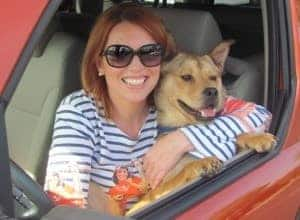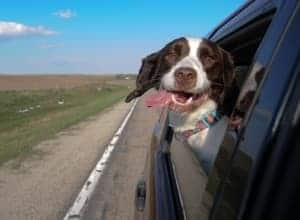Most dogs love going on car rides, but some states demand that you restrain your dog. There’s also the question of whether car insurance covers your dog.
A Carinsurance.com survey of 1,000 people asked respondents about driving with their pets. The survey found that 84% said they bring their pets on the road. Dogs are the more likely road warriors — 86% who travel with their pets said they take their dogs. That’s compared to only 12% who travel with cats.
Fifty percent of people who take their pets say they bring them to a park or for a walk, while 45% said they take them on road trips. Forty-three percent said they drive around Fido and Tabby for no specific reason.
Running errands is a common reason to bring a pet companion. Thirty-six percent said they take their pets on errands, 24% pick up the kids at school and 19% take their pets everywhere.
Experts recommend you restrain your pet in the car. However, we found more than half of respondents don’t always put their pets in a car restraint.
- 40% said they always restrain their pets when in the car.
- 30% said they sometimes restrain them.
- 29% said they never restrain their pets in the car.
Men are more likely to restrain their pets than women (45% of men compared to 38% of women).
More than one-third of pet owners (37%) who bring their animal companions let them sit in their laps, including 47% of men. That isn’t the safest place for pets. A misplaced step could cause you to lose concentration on the road.
Sometimes that can lead to an accident. Fifteen percent of drivers with pet passengers said they’ve been in an accident or “near miss” because of a distracting pet, including 22% of men.
However, only 8% of those surveyed consider an unrestrained pet the biggest driving distraction. It landed fourth on a list of five driving distractions:
- Texting while driving — 59%
- Talking on a mobile phone — 20%
- Disruptive children — 9%
- Unrestrained pets — 8%
- Changing radio stations — 4%
Despite few seeing unrestrained pets as the biggest driving distraction, 42% said state laws should require restrained pets in the car, including 47% of men.
Pets and car insurance
Car insurance covers damage to your car (or someone else’s) if you get into an accident with or without a pet in the vehicle, but your vet bills are most likely your own — especially if you’re at fault.
“Your liability car insurance will cover damage to the other driver’s car and injuries suffered by other drivers and passengers, up to your policy limits, if you cause a collision because you were distracted by your pet, regardless of whether the pet was restrained or not,” said Carole Walker, executive director at the Rocky Mountain Insurance Information Association.
If you cause an accident because of a distracted pet, a policy’s collision coverage would cover damage, said Walker.
Your pet, on the other hand, may not be so lucky.
“You will be responsible for any vet bills if the accident was your fault,” said Penny Gusner, senior consumer analyst at Carinsurance.com. “Pets fall under the personal property category and while some collision and comprehensive policies extend to pets, it’s the exception. Most only cover damage to your vehicle.”
Some insurers, however, offer pet coverage under a policy’s collision portion. Cover levels vary, but the average is typically between $1,000 and $2,000. That may not be enough to pay medical bills for a seriously injured pet.
You may want to add a policy endorsement if your insurance doesn’t say a pet is covered. The endorsement won’t cost much if you have comprehensive and collision coverage.
“If the other driver is at fault, you should be able to make a claim against his or her property damage liability coverage to cover Fido’s bills,” said Gusner.
Auto insurance pet injury coverage
Let’s take a look at the pet injury coverage that’s part of collision coverage or an endorsement offered by auto insurance companies:
- Arbella – Pet lover’s endorsement pays up to $500 in medical expenses for a cat or dog injured in your car during an accident.
- Erie – Pet injury coverage has a limit of $500 per dog or car with $1,000 in total vet bills for all animals hurt in a crash.
- Farm Bureau – Pet injury coverage is part of collision coverage, comes with a $500 limit and covers cats and dogs injured in an auto accident.
- Grange – Offers pet injury and mobile insurance if a pet or mobile device is damaged in an auto accident.
- Hanover – Offers pet injury coverage endorsement of up to $2,500 if a cat or dog is injured or killed in an auto accident.
- Kemper Direct – Added pet protection can get up to $2,000 in medical expense coverage for a cat or dog injured in a covered accident.
- Metromile – Offers pet injury protection with collision and comprehensive coverage. Covers up to $1,000 if cat or dog is hurt in a covered claim.
- Plymouth Rock Assurance – Provides coverage if your dog or cat is injured or killed as a result of a covered loss. Increased limits are available when combined with a preferred package.
- Progressive – Pet injury protection is included under collision coverage and pays up to $1,000 for medical care for a dog or cat that is hurt in an auto accident (regardless of fault).
- Safeco – Pet coverage helps pay for veterinary expenses or death benefits if a dog or cat is injured in an auto accident.
- Safety Insurance – Has pet injury protection coverage available for auto policies.
Pet insurance
Pet insurance is one way to get help with paying for your furry friend’s medical call.
“Accident coverage applies when your pet is injured. This could be a leg injury after jumping off the couch or for an object ingestion (eating a sock or other item that won’t pass), among other things, which could also include being injured by a vehicle,”said Liz Watson, vice president at Crum & Forster Pet Insurance Group, a provider of ASPCA Pet Health Insurance.
Pet insurance works differently than a human’s health insurance.
“Generally speaking, pet health insurance works on a reimbursement basis. Pet parents pay their veterinarian and then submit their invoice as a claim to the insurance company. Reimbursement percentage, which is selected at the time of starting a policy, is typically 90, 80 or 70%, for eligible conditions, after meeting the annual deductible,” Watson said.
Pet insurance has various caps, limits and waiting periods. One is an annual limit that pet parents select when purchasing the policy. The annual limit is the maximum amount that will be reimbursed annually, Watson said.
Vet bills can easily run into thousands of dollars.
“Car accident injuries range from mild to severe depending on the speed of the accident,” said Dr. Andrea Stickland of the Animal Medical Center in Chandler, AZ.
Strickland said common low-speed injuries include spiral irritation, which can result in limping. Higher-speed accidents can lead to collapsed lungs and pets getting thrown from vehicles.
“Unfortunately, we see a lot of different conditions and accidents come through in our claims data, which is why pet insurance is so important because you never know what is going to happen nor when it’s going to happen,” said Watson.
Pet insurance costs vary depending on the type, size and age of the pet, so it’s vital to do your homework.
“Research the various providers and understand differences between coverage. While there is much similarity, you’ll certainly find differences. For instance, some policies don’t cover exam fees. Another item to be aware of is whether the deductible is annual or per incident,” Watson said.
Laws for pets in cars
Letting your pet roam around the car is not only a bad idea. It’s illegal in some states:
- New Jersey — Allows New Jersey Society for the Prevention of Cruelty to Animals officers to stop drivers they feel are improperly transporting animals. Tickets range from $250 to $1,000 per offense.
- Hawaii — Forbids drivers from having pets on their laps.
- Arizona, Connecticut, Iowa, Maine, Massachusetts, South Carolina, Washington, Washington, D.C. and Wisconsin — Considers unrestrained pets on drivers’ laps distracted driving.
- Rhode Island — Dogs need to be in an enclosed area and restrained in either a crate or seatbelt. Fines are up to $200 per offense.
Also, 17 states have laws that expressly prohibit leaving an animal confined in a vehicle:
- Arizona
- California
- Illinois
- Maine
- Maryland
- Minnesota
- Nevada
- New Hampshire
- New Jersey
- New York
- North Carolina
- North Dakota
- Rhode Island
- South Dakota
- Vermont
- Tennessee
- West Virginia
Typically, the conditions have to endanger the animal’s life for the law to be violated. Penalties vary by state.
Under some state laws, police or other individuals are allowed to rescue animals left under extreme conditions and not be held liable for damage.
How to keep your pet safe in the car?
Drivers should practice best safety precautions — even if the state doesn’t require the restraint of your dog or other animals. It’s important to restrain your pet as if it’s a child. In a crash, unrestrained animals become projectiles and could injure or kill someone else in the car, as well as suffer injuries themselves.
Shari-Ann Murphy, owner of PAWS Training Group in Ludlow, MA, said it’s always important to restrain your pet in the car.
“Crating your dog in the car is the safest way to travel. With a crate, you can anchor it down, so if you hit traffic suddenly, you can brake without worrying about the crate rolling around,” Murphy said.
Dr. Rebecca Greenstein, veterinary medical advisor at Rover, offers these tips for a crate.
“A crate or carrier should be large enough for a pet to stand up and turn around, but not so large that an animal could be thrown and risk injury in case of an accident,” Greenstein said.
However, not every pet parent drives in a large enough vehicle to fit a large crate. Seat belt tethers are another option, Murphy said.
“Seatbelt tethering is my go-to for all large dogs. You can find metal chain tie-downs for about $13 on Amazon. The best kind of tether will have a clip and part that will snag right into the seat belt receiver like your seatbelt does. Being metal, they cannot chew through it,” Murphy adds.
If you use a seatbelt, make sure to put your pet in a harness and not a collar. You could choke your dog if you attach the tether to a collar and brake too hard.
You can also use a doggy car seat for small pets.
“You can get ones that hang over the handrest of your passenger seat or one that anchors down on top of your armrest. As always, please use a harness and not a collar to tether them down with,” Murphy said.
Putting dogs in a pickup truck bed is legal in some states, but Laura Adams, safety and education analyst at Aceable, suggested drivers use immobilized crates instead.
“Securely fasten them to the bed up against the rear window area. If you have a truck cap, that’s an excellent way to add a layer of protection for your pets,” Adams said.
Dr. Rona Shapiro, a veterinarian with Diley Hill Animal Emergency Center, Easton Animal Hospital and Groveport Canal Animal Hospital in Ohio, said another issue for pets is leaving them in hot cars. A car’s temperature can skyrocket even on a cool day and with the windows cracked open.
“Hot cars and unrestrained pets are seriously dangerous and cause entirely preventable injuries, deaths, and car accidents. Please properly restrain your pets and keep them cool. Your pets, your veterinarian and your insurance company all thank you,” Shapiro said.
Pet travel safety tips
Keeping a pet safe goes beyond strapping it in correctly. Here are tips to keep your pet safe on road trips:
- Make sure your dog is comfortable on the trip by bringing some snacks, water and a water bowl.
- Stop every couple of hours for your dog to relieve itself and scratch its legs.
- Bring a copy of your dog’s vaccines if you travel out of state. Murphy said most pet parents don’t know that you’re required to have a copy of your dog’s vaccines when you cross state lines. If you can’t provide vaccination records, officials in another state could quarantine your dog.
- Travel with a pet-specific first aid kit, extra food and a physician picture of your dog if it gets lost. Murphy said part of your first aid kit should include a list of veterinarians and emergency veterinarians for where you’re traveling.
- Evaluate your pets’ overall comfort during car riders. Many dogs love road trips, while others may feel anxiety and get motion sickness. In some cases, leaving your dog at home might be the most appropriate and safest option.
- Never allow your dog to stick its head out the window. It’s dangerous for the dog and can lead to tragic results.
- Don’t leave a pet unattended in the car. “As the mercury rises, it is imperative to remind everyone never to leave a pet in a parked car, even for what you think is a short period. Without the air conditioner on, it takes only minutes for a car to turn into a virtual oven. Hot car deaths for pets are completely preventable. There is no excuse for pet owners to leave their pets in hot cars and doing so is currently illegal in most jurisdictions,” Greenstein said.
- Get immediate veterinary help if your pet has been in a hot environment and seems unusually quiet, panting excessively, vomiting, appears weak or shows signs of seizures or collapse or other symptoms of heatstroke. “Early veterinary medical intervention can make the difference between life and death,” Greenstein said.







